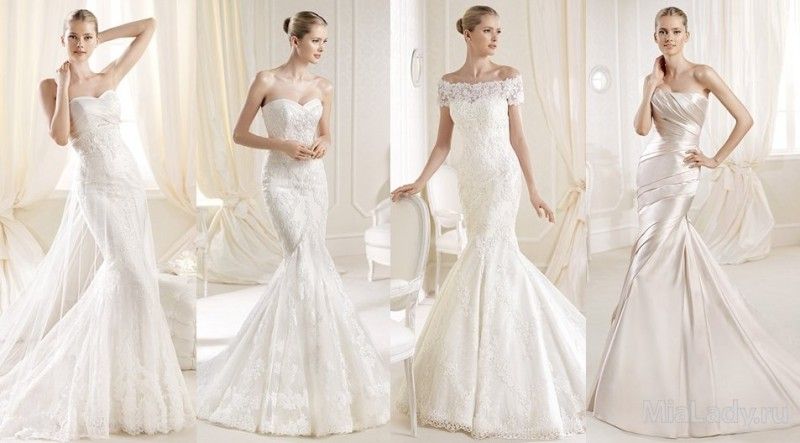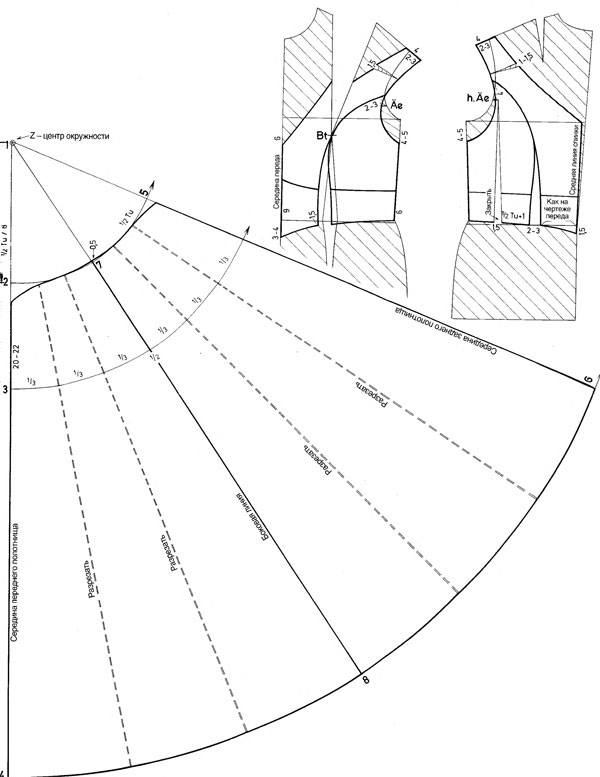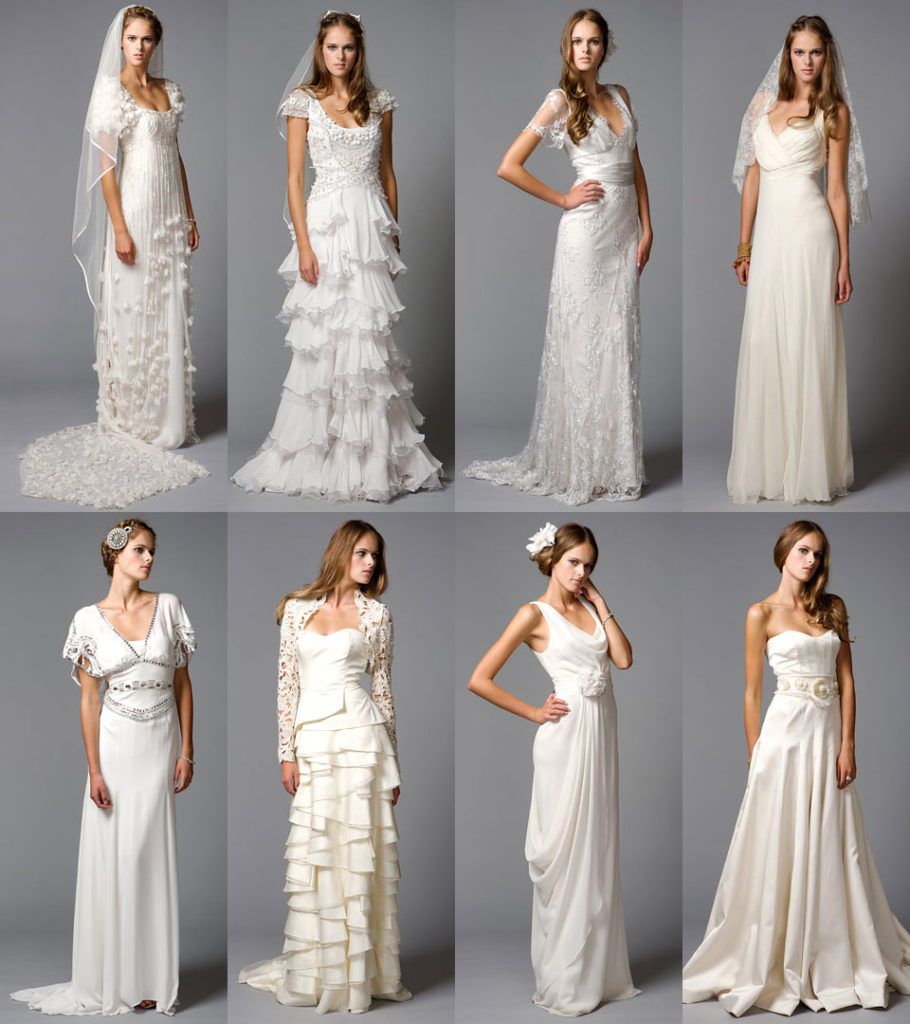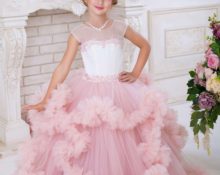 Available in Rus' a good wedding tradition, now quite forgotten - the bride sews her wedding dress herself.
Available in Rus' a good wedding tradition, now quite forgotten - the bride sews her wedding dress herself.
Recently, more and more girls are deciding to take this decisive step - to prepare the main outfit in life themselves.
We will try to do this competently, quickly, and at the lowest cost.
Assessing the pros and cons of your figure in the mirror
The main task of a bride at a wedding is to be beautiful! The slightest miscalculation in the image can knock the impressionable bride out of the saddle. This means we think through the outfit down to the smallest detail.
Let's start by recognizing our shortcomings and identifying our strengths.
 Posture
Posture
Stand barefoot on a vertical surface, press your shoulder blades and heels against it:
- If you feel comfortable in this position, then you have normal posture.
- If the back of your head presses with difficulty, you have to bend your neck to do this, which means you have a stooped figure.
- Provided that the shoulder blades do not “want” to touch the wall, we can talk about a kinked figure.
 It is important to consider your body type:
It is important to consider your body type:
- Circle. This type is also called an apple.
- Triangle (there are two types, depending on the position of the base of the triangle). The figure - a triangle with the base downwards is also called a pear.
- Hourglass.
- Rectangle.
 These are the main types, there are several more transitional ones.
These are the main types, there are several more transitional ones.
 Depending on these types, different styles of dresses will suit you.
Depending on these types, different styles of dresses will suit you.
Advice! Before sewing, be sure to visit several stores, try on dresses of different cuts, perhaps a style you haven’t even thought about will suit you. All that remains is to bring it to life.
Wedding dress models
Wedding dresses are available classified according to a variety of parameters. First of all, this is their length.:
- Short - mini. Micros are practically never found.
- Dresses of medium length - midi. From mid-calf to ankle.
- Maxi to the floor. The most common length of wedding dresses.
- Dresses with gradient hem length.
 According to the silhouette, the following styles are distinguished:
According to the silhouette, the following styles are distinguished:
Ballroom. It involves a tight-fitting bodice and a loose, often multi-layered skirt. Almost always there are one or more petticoats, and it is possible to use a hoop.
 Empire style, and also close to it Greek/antique style. High waist, lots of draperies on the chest and under it, short sleeves, or no sleeves at all. One of the most advantageous styles for sewing yourself.
Empire style, and also close to it Greek/antique style. High waist, lots of draperies on the chest and under it, short sleeves, or no sleeves at all. One of the most advantageous styles for sewing yourself.
 Mermaid/fish – the upper part of the dress is sewn exactly to the figure, it fits the body as closely as possible to the hip or knee, below the skirt widens quite sharply towards the hem. Most often, the pattern is used for a year or a cut-off bottom of the dress.
Mermaid/fish – the upper part of the dress is sewn exactly to the figure, it fits the body as closely as possible to the hip or knee, below the skirt widens quite sharply towards the hem. Most often, the pattern is used for a year or a cut-off bottom of the dress.

Mermaid fish for the perfect figure
Princess/A-line. As a rule, sleeveless, the upper part is represented by a bodice, the panel of the skirt is an A silhouette.
 Straight dress. Smoothly follows the contours of the body, but without being too tight. The skirt widens slightly towards the hem.
Straight dress. Smoothly follows the contours of the body, but without being too tight. The skirt widens slightly towards the hem.
Reference! Fizhma – a skirt with a frame made of whalebone, plastic, metal. Necessary for creating voluminous “court” skirts. In some subcultures (goths, emo, etc.), it can be used as an independent item of clothing.
Color, materials and accessories
White is considered the traditional color for a wedding dress, but you shouldn’t force yourself into rigid limits.
Variations of white and beige colors are suitable for brides:
- Ivory;
- ivory;
- lactic;
- coffee with milk;
- the color of melted chocolate ice cream.
If any bright color unconditionally suits you, feel free to sew yourself a dress of that exact shade.
 The choice of material directly depends on the style and style of your outfit. Frequently used ones include:
The choice of material directly depends on the style and style of your outfit. Frequently used ones include:
- natural, artificial silk;
- chiffon, georgette;
- lace, guipure;
- tulle, tulle;
- satin, satin;
- knitwear, supplex;
- taffeta;
- cotton, linen in various proportions.
How to cut and sew wedding dresses?
It is possible to design a wedding dress pattern yourself. For this We need a pattern - a basis. By changing the length and width of the skirt, deepening the neckline and modeling different types of sleeves, we get a completely unique image.
We sew a simple wedding dress with our own hands
A short trapezoidal dress made of embroidery or lace is suitable for a young bride.
In combination with a short veil, or even a floral wreath instead, this outfit will look very fresh.
Required:
- Guipure, sewing, lace - in an amount equal to the length of your dress, with a width of 150 cm.
- Fabric for lining, preferably wrinkle-resistant and breathable.
- Accessories.
- Buttons, if you decide to use them as trim.
- Zip closure.
- Finished bias binding.
 Pattern
Pattern
We will need the following measurements:
- Waist circumference.
- Chest circumference.
- Hip girth.
- Dress length.
- Neck circumference.
- Chest height.
 We will get the following details:
We will get the following details:
- Shelf – 1 piece with a fold.
- Back – 2 parts.
Advice! If you do not use ready-made bias tape to finish the neckline and armholes, you will need to make a facing pattern.
How to create a pattern for a similar dress yourself using a base pattern:
We cut the base vertically along the dart line.
 Add flare.
Add flare.
 Make the side seam straight.
Make the side seam straight.
Advice! If you use lace with scallops and other trim on one side and run this section along the hem, then the bottom of the dress does not need to be hemmed.
Progress:
- We place the parts on the prepared fabric, taking into account the grain thread, and chalk it.
- We carry out the same operations with a product made from lining fabric; it will be sewn separately, only the shoulder seams, neckline and armhole will be sewn together.
- We cut it out.
- Sew the side seams.
- Sew the middle back seam, leaving 20-25 cm for the zipper.
- We chop off the parts of the case and the main product.
- Sew the shoulder seams.
- We sew in a zipper.
Important! We iron each seam through an ironing iron, if the fabric allows it.
- We process the armholes and neckline with bias tape.
- Hem the hem.
- We decorate.
Advice! If desired, you can cut out the sleeves according to the main pattern, since our actions did not affect the armhole and sleeve.
Outfit with a full skirt

The second option for making a dress can be a set consisting of a removable bodice and a full skirt. The connection line can be emphasized, or, conversely, hidden under a wide belt.
Required:
- Supplex, knitwear, any elastic fabric for a bodice of a suitable shade - the quantity for a fabric width of 150 cm is usually equal to the height of the bodice.
- Tulle, tulle or guipure for a skirt - approximately 4 product lengths for a two-layer skirt.
- Rubber.
- Bra, bodysuit, breast cups or just underwire – you choose what suits you best.
- Optional accessories.
 Pattern
Pattern
We model the corsage using the base pattern.
 Our The pattern is given for size 48, this corsage can also be sewn from satin or satin.
Our The pattern is given for size 48, this corsage can also be sewn from satin or satin.
Skirt semi-sun or sun, in the latter case, fabric consumption doubles.
The pattern of the “sunny” skirt is built according to this drawing:
- Your task is to choose which specific skirt you want, measure the waist circumference, as well as the length of the skirt.
- We calculate the radius of the thallium circle; to do this, we multiply the half-circumference of the waist by a coefficient and select it from the table above the figure.
- On a sheet of whatman paper or wallpaper we build a right angle, measure our radius from the left corner.
- We draw a circle.
- We measure the required length of the skirt and draw a second circle.
- Adjusting the bottom.
- The pattern is ready.
 Progress:
Progress:
- We cut out the details. Don't forget the seam allowances.
- We sweep away the reliefs.
- Let's grind.
- We baste the cups from the wrong side or sew on a strapless bra. Let's try it on.
- We process all cuts with bias tape.
- We cut out the skirt(s). It is better to use tulle - it does not wrinkle, does not fray and can be cut in any direction.
- Sew the side seam/seams. Leave some space for the zipper.
- We sew in a zipper.
- Sew on the belt.
- The bottom of the tulle skirt does not need to be processed.
- From a piece of silk, satin, organza, we cut out a belt 1.5-2.5 m long. Sew it together and turn it inside out through a small hole.
- Steam.
- We tie it at the back of the waist with a beautiful bow and straighten it out.
 Dress A - silhouette:
Dress A - silhouette:
An interesting option for a combined dress:
 These two dresses are sewn according to the same principles as the previous ones, being a combination of them.
These two dresses are sewn according to the same principles as the previous ones, being a combination of them.
 Advice! It is advisable to first make any wedding dress from cheap fabric, make adjustments to the pattern, and then take on expensive fabric.
Advice! It is advisable to first make any wedding dress from cheap fabric, make adjustments to the pattern, and then take on expensive fabric.
Decorating a wedding dress
This is exactly the case when It’s difficult to overdo it with finishing:
- rhinestones;
- volumetric embroidery, including ribbons;
- beads, bugles, beads;
- artificial, natural pearls;
- rhinestones, brooches.
Important! An abundance of decorations will look appropriate if they are all matched exactly to the tone of the fabric of the dress; this will prevent the bride from turning into a New Year tree.
A wedding is one of the most important days in a woman’s life, prepare for it in advance so that nothing overshadows it, and your eyes glow with genuine happiness.


 Reference! Fizhma – a skirt with a frame made of whalebone, plastic, metal. Necessary for creating voluminous “court” skirts. In some subcultures (goths, emo, etc.), it can be used as an independent item of clothing.
Reference! Fizhma – a skirt with a frame made of whalebone, plastic, metal. Necessary for creating voluminous “court” skirts. In some subcultures (goths, emo, etc.), it can be used as an independent item of clothing. Advice! If you use lace with scallops and other trim on one side and run this section along the hem, then the bottom of the dress does not need to be hemmed.
Advice! If you use lace with scallops and other trim on one side and run this section along the hem, then the bottom of the dress does not need to be hemmed. Important! An abundance of decorations will look appropriate if they are all matched exactly to the tone of the fabric of the dress; this will prevent the bride from turning into a New Year tree.
Important! An abundance of decorations will look appropriate if they are all matched exactly to the tone of the fabric of the dress; this will prevent the bride from turning into a New Year tree. 0
0





